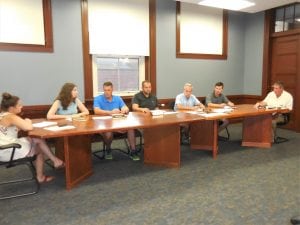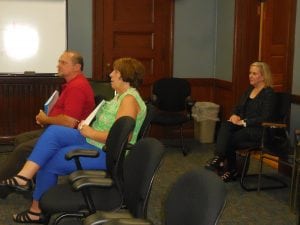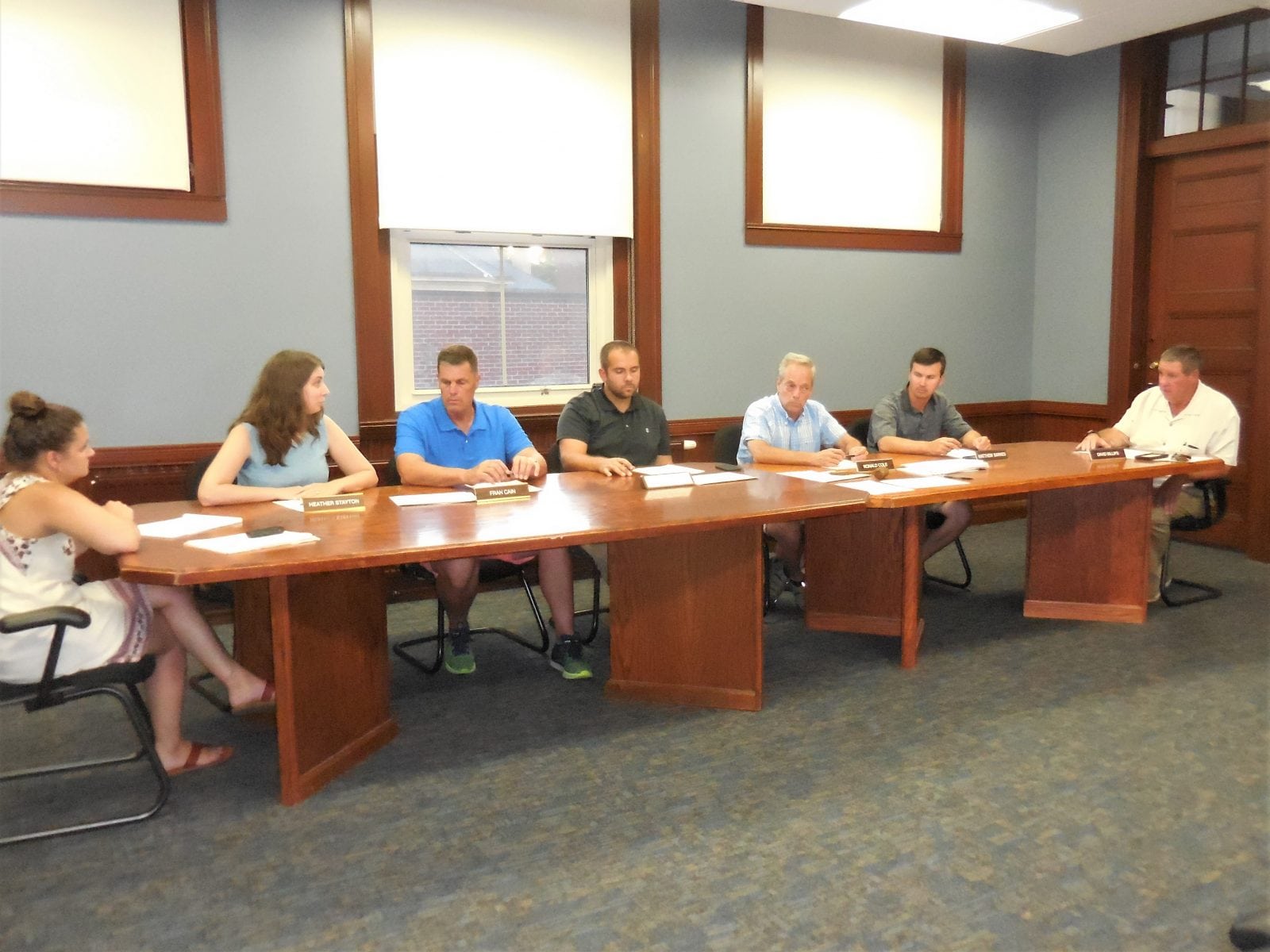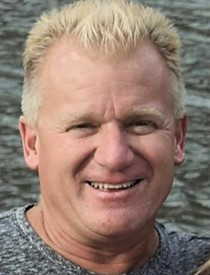
Water Commission and DPW staff met on Tuesday. (Photo by Amy Porter)
WESTFIELD – The Water Commission met on Tuesday to talk about the water restriction, the meter replacement project, and to hear updates on projects funded by the $13 million water bond. Before any of that business was conducted, however; time was spent responding to a letter received from At-large Councilor Dave Flaherty that he requested be addressed during public participation. Flaherty said he could not be there due to a scheduling conflict.
The letter, which Department of Public Works Director David Billips read in part, and former Ward 4 Councilor Mary O’Connell came to support, offered suggestions to the Water Commission to quell residents’ concerns about contamination by perfluoroalkyl substances in the water supply.
The first suggestion Flaherty made was to ask the Water Commission to consider setting its standards for threshold levels lower than those currently required in Massachusetts, since their goal is “non-detect” for the compounds.
Billips said the threshold standards are set by the Department of Environmental Protection and the Environmental Protection Agency. He said if the city is treating the water and going for “non-detect,” it doesn’t matter. He also said the city may at times set lower standards for industry, but it doesn’t set standards for itself.
“Right now, our goal is the lowest level that can be detected. You can’t set it lower than that,” Billips said.
Systems Engineer Heather Stayton added that the levels differ for different perfluorinated compounds. “However low their levels go, we want it to not be there. We’ll change out before any gets there,” Stayton said.
Commissioner Ronald Cole asked Stayton what would be the frequency of testing. Stayton replied that currently the DEP is requiring quarterly testing before the treatment comes online. She said she is trying to get information on the requirements after it comes online, but that it would not be tested less often. She said the city will test the water before it enters the filtration vessel, in the vessel at different levels, and after the vessel.
“I know other states have set stricter standards,” O’Connell said. “People are concerned about this. I understand your commitment to non-detect. I’d like to see it in writing to reassure people,” she added.
“As far as making the commitment to the people of Westfield, this Water Department has been doing that for decades. We’ve always had that commitment,” Billips said, later adding that people with no knowledge of the system have made statements about people in the department, which he called “reprehensible.”

DPW Systems Engineer Heather Stayton and Assistant Director Francis Cain. (Photo by Amy Porter)
“From my standpoint, if we were to set some numerical standard, it would not be as flexible as our commitment to non-detect,” Stayton said.
The second suggestion made by Flaherty in the letter was based on “concern in the community that our filters will not be swapped out before ‘breakthrough’ of harmful Perfluoroalkyls.” Flaherty suggested that policies and procedures of the department for the use of the filtration system and the timing of replacement be made available to the public.
Billips said when a new process is brought online, it always comes with a formal plan, including how often it will be tested and changed out.
“The question is would that be available to the public,” Cole asked. Billips said they would put the testing policy out there.
“With each component, operation manuals are developed,” Stayton said, adding they are too large to put online, but could be made available for the public to view, but not copy. She said the manuals are “living documents” that are changed and updated over time, and the only copy should be with the operator. “I would not want multiple copies out there,” she said.
“From a security standpoint, you don’t want that information out there,” said DPW Assistant Director Francis Cain. He added that the documents for the vessels alone were “just shy of” 500 pages.

City Engineer Mark Cressotti, Mary O”Connell, and Councilor Cindy C. Harris at Water Commission meeting. (Photo by Amy Porter)
O’Connell asked whether general policy information would satisfy Flaherty’s request. Billips repeated that it sounded as though the testing schedule was the information being requested, which they could supply.
“We are here to make sure it’s as good as it can get. Our commitment to zero detect is a testament to that,” added Cole.
The third suggestion in the letter was to post all water testing results within five days. Stayton said all testing has been posted for the last year and a half. She said the results generally take two weeks, after which she sends them to Information Technology to post. She said sometimes, if they question the validity of a test, they will do a confirmation test before posting; adding that generally occurs when the results are lower than expected.
“We do get it out as quickly as we can,” Stayton said.
“I just came on behalf of Dave (Flaherty). These are just suggestions. Any board or commission should be open communication,” O’Connell said, before asking Billips to read the close of the letter out loud:
“I know that we have dedicated talented people on the Water Commission and in the Water Department, and that they do their best to ensure that we deliver safe reliable water to people in town. However, this particular issue has scared people (and enraged a bunch of people), and I think we – the city – need to make extra efforts to assure them that the water is safe, and that we are doing everything we can to remove Perfluoroalkyl substances, and other nasty stuff, from the water supply,” Flaherty wrote.
“I think all of you do a tremendous job,” said At-large Councilor Cindy C. Harris, before the public participation closed. Harris said she has always expressed her support for the department, and is behind them 100%. Both Billips and Cole thanked her for her support of the work they’re doing.








